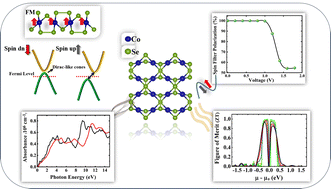Thermoelectric, spin-dependent optical and quantum transport properties of 2D half-metallic Co2Se3
Abstract
In this paper, the thermoelectric, spin-dependent optical and quantum transport properties of a two-dimensional (2D) Co2Se3 monolayer are investigated using first principles calculations. The stability of the Co2Se3 monolayer is confirmed by energy-cohesive calculations and phonon dispersion analysis. According to electronic and magnetic calculations, Co2Se3 is a Dirac half-metal (DHM) with several Dirac cones around the Fermi level in the spin-down channel and exhibits intrinsic ferromagnetism with a high Curie temperature. Investigation of the thermoelectric properties shows that the Co2Se3 monolayer with ZT ∼ 1 at low temperature (T < 300 K) to medium temperature (500 < T < 700 K) can be introduced as a suitable candidate for thermoelectric applications. Spin-dependent optical calculations indicate that the maximum reflection and absorption for 2D Co2Se3 are in the energy ranges of 0–1 and 12–8 eV, respectively, so this structure is a suitable wave reflector in the infrared range (IR) and a good absorbent in the far-ultraviolet (FUV) range. On the other hand, the unique feature of Co2Se3 encouraged us to study the spin-dependent transport properties. A spin-down current as large as 27(30) μA passing through in the x(y)-direction, while the spin-up current passing through the scattering region up to 1.2 (1) V is approximately zero, induces 100% spin filtering properties in the Co2Se3 monolayer, so this structure has great potential for application in spintronic nano-devices.



 Please wait while we load your content...
Please wait while we load your content...